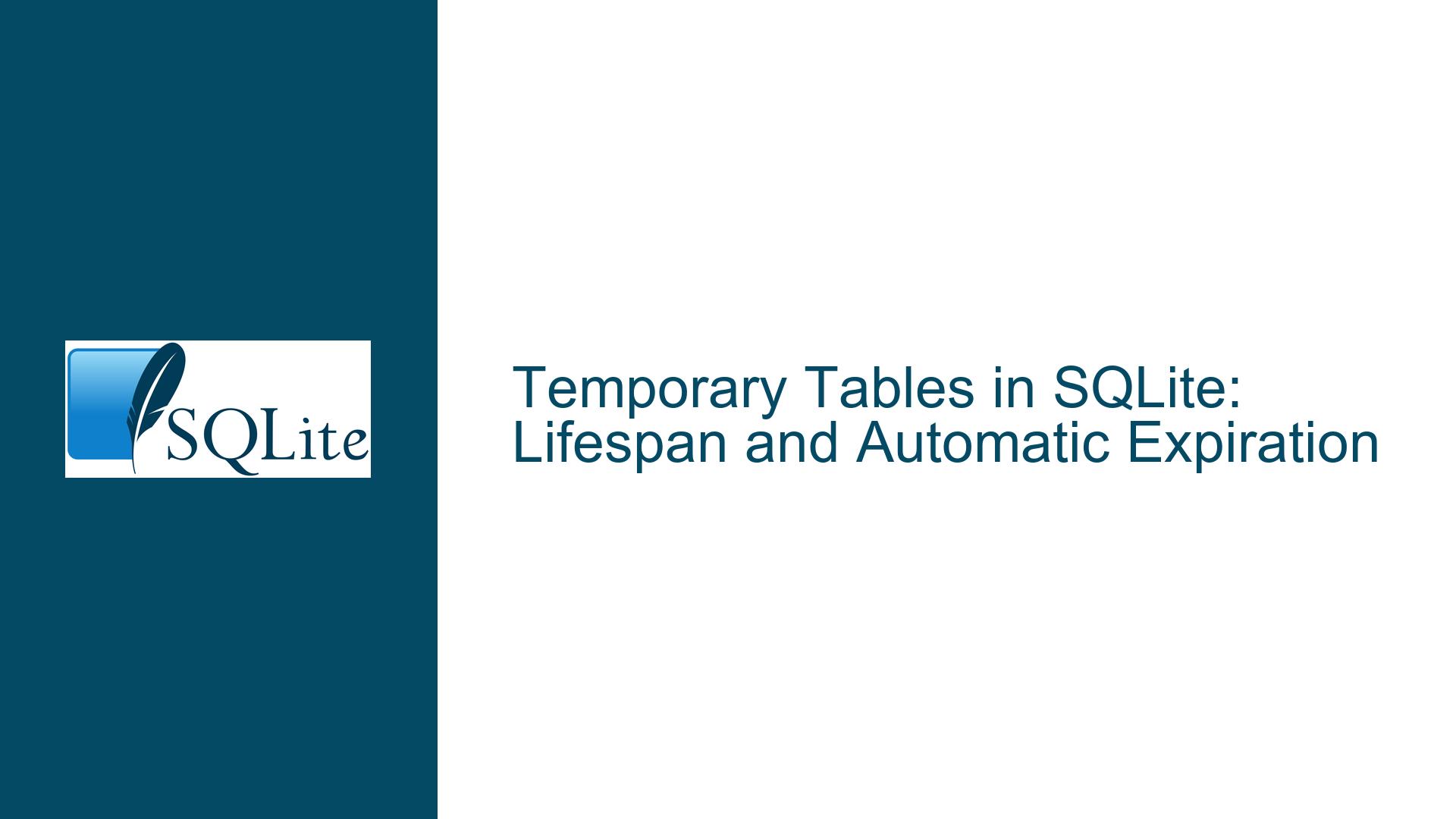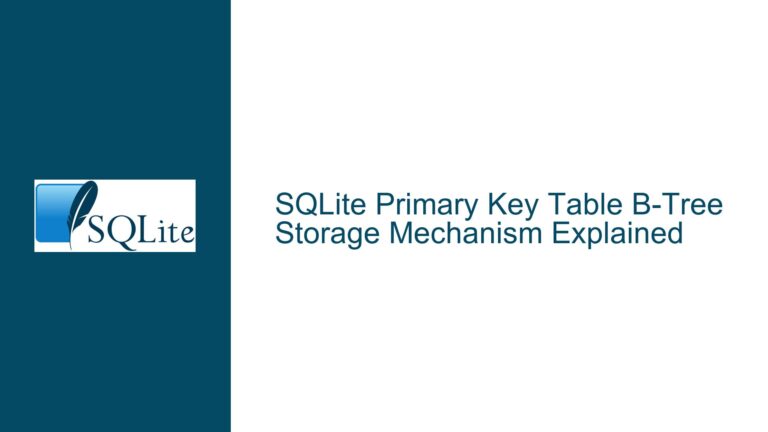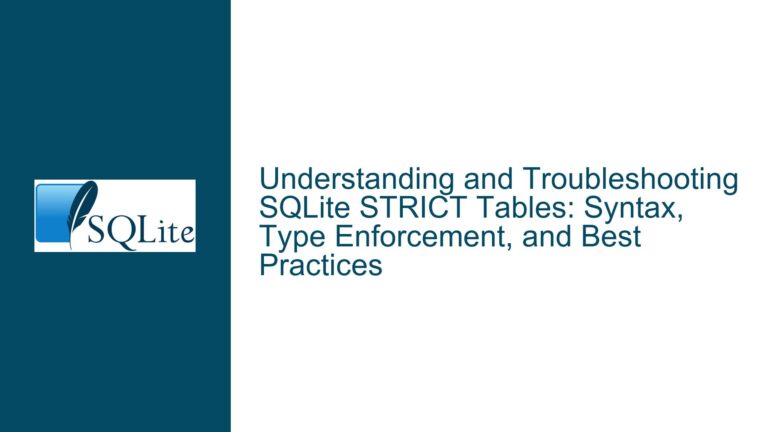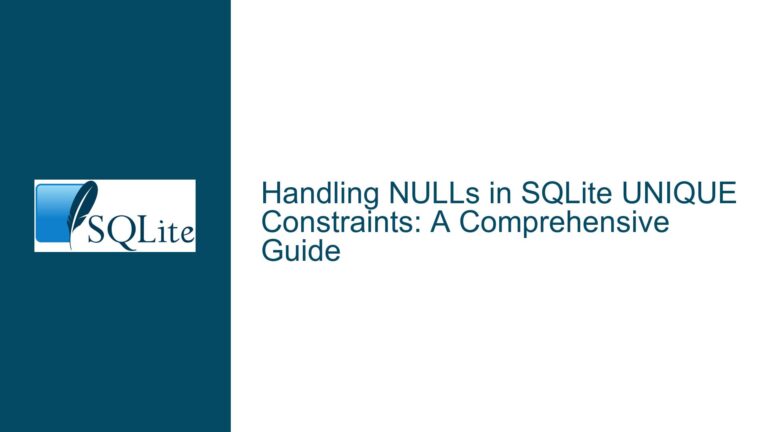Temporary Tables in SQLite: Lifespan and Automatic Expiration
Understanding Temporary Table Behavior in SQLite vs. PostgreSQL
The concept of temporary tables in SQLite differs fundamentally from PostgreSQL and other relational database systems. While PostgreSQL automatically drops temporary tables at the end of a session or transaction, SQLite implements temporary storage through a distinct mechanism involving schema-bound objects. A temporary table in SQLite is not truly ephemeral in the conventional sense but rather persists for the lifetime of the database connection that created it. This distinction arises from SQLite’s architecture as an embedded database without server-side session management.
In SQLite, the CREATE TEMP TABLE or CREATE TEMPORARY TABLE syntax creates a permanent table within a special temp schema that exists only for the specific database connection. This temp schema acts as a container for all temporary objects (tables, indices, views) associated with that connection. When the connection closes, SQLite automatically destroys the entire temp schema and its contents. This behavior contrasts with PostgreSQL’s approach where temporary tables exist at the session level and may be transaction-scoped when using ON COMMIT DROP.
The temp schema implementation explains several key characteristics:
- Connection Isolation: Two concurrent connections to the same database file will have completely separate temp schemas
- Persistent Storage Medium: By default, temporary tables reside on disk (in the
tempjournal mode) unless using:memory:URI connections - Explicit Cleanup Requirements: No automatic row expiration exists – all data remains until connection closure
- Schema Qualification: Temporary tables can be referenced via
temp.tablenamesyntax
A common misunderstanding arises from equating SQLite’s temporary tables with PostgreSQL’s transactional temporary tables. Consider this PostgreSQL example:
BEGIN;
CREATE TEMP TABLE session_data (id SERIAL, content TEXT) ON COMMIT DROP;
-- Table automatically drops at COMMIT/ROLLBACK
SQLite lacks equivalent functionality. The closest approximation requires manual cleanup:
CREATE TEMP TABLE session_data (id INTEGER PRIMARY KEY, content TEXT);
-- Application must explicitly DROP TABLE before connection closes
The disk-backed nature of SQLite temporary tables can lead to performance implications. While the temp schema uses a separate storage paradigm from main databases (often employing in-memory storage for TEMP database in PRAGMA temp_store=2 mode), developers must understand that temporary tables are not inherently faster – their performance characteristics depend on the connection’s temp_store configuration and available memory.
Common Misconceptions About Temporary Data Lifespan and Syntax Compatibility
Two primary areas of confusion emerge from the forum discussion: automatic data expiration expectations and syntax incompatibilities between PostgreSQL and SQLite. Developers transitioning from PostgreSQL often assume equivalent temporal data handling capabilities, leading to incorrect implementations.
False Assumption 1: Session-Based Automatic Cleanup
PostgreSQL’s temporary table lifecycle management creates an expectation that SQLite will automatically purge data when certain conditions occur. However, SQLite temp tables:
- Persist through multiple transactions
- Survive ROLLBACK operations
- Require explicit DROP TABLE commands or connection termination for removal
This leads to scenarios where temporary tables accumulate stale data across transactions if not properly managed. The absence of ON COMMIT DROP clauses in SQLite means developers must implement their own cleanup logic.
False Assumption 2: Temporal Data Expiration Syntax
The presented DELETE statement demonstrates a PostgreSQL-specific interval syntax:
DELETE FROM limiter WHERE timestamp < CURRENT_TIMESTAMP - INTERVAL '2 days';
SQLite does not support INTERVAL literals. Its date/time functions require using modifiers with the datetime() function:
DELETE FROM limiter WHERE timestamp < datetime('now', '-2 days');
This syntax difference often trips developers accustomed to PostgreSQL’s interval handling. Furthermore, SQLite’s datetime functions assume UTC time unless modified by PRAGMA directives like localtime.
False Assumption 3: Transaction-Scoped Temporary Tables
While PostgreSQL allows creating temporary tables that exist only within a transaction block, SQLite’s temporary tables always persist until connection closure. This leads to memory bloat in long-lived connections that create multiple temporary tables without explicit cleanup.
False Assumption 4: Temporary Table Visibility
In PostgreSQL, temporary tables are visible to all transactions within the same session. SQLite’s temp schema isolation means temporary tables are only visible to the connection that created them, even if multiple connections access the same database file.
Implementing Temporary Data Storage with Automatic Expiration in SQLite
To achieve PostgreSQL-style temporary data handling in SQLite, developers must combine multiple features: temporary schemas, date/time functions, and trigger-based automation. The following implementation strategies address both connection-bound temporary storage and time-based data expiration.
Strategy 1: Proper Temporary Table Usage
Create connection-specific temporary tables using explicit schema qualification:
CREATE TEMP TABLE session_cache (
id INTEGER PRIMARY KEY,
data BLOB,
created_at DATETIME DEFAULT CURRENT_TIMESTAMP
);
This table will persist until the connection closes. To emulate transaction-scoped behavior, wrap usage in savepoints:
SAVEPOINT start_transaction;
-- Use temp table
RELEASE start_transaction;
DISCARD TEMP; -- Custom function needed (see below)
A helper function can automate temp table cleanup:
CREATE TEMP TRIGGER IF NOT EXISTS discard_temp
AFTER COMMIT
BEGIN
DROP TABLE IF EXISTS session_cache;
END;
Note: SQLite does not natively support AFTER COMMIT triggers. This requires using application-level hooks.
Strategy 2: Time-Based Data Expiration
For tables requiring automatic row expiration, implement a trigger-based cleanup system:
CREATE TABLE limiter (
id INTEGER PRIMARY KEY,
data TEXT,
timestamp DATETIME DEFAULT (datetime('now'))
);
CREATE TRIGGER purge_old_entries
AFTER INSERT ON limiter
BEGIN
DELETE FROM limiter
WHERE timestamp < datetime('now', '-2 days');
END;
This trigger purges entries older than two days whenever a new row inserts. For more efficient cleanup, schedule periodic vacuuming:
CREATE TRIGGER hourly_cleanup
AFTER INSERT ON some_frequent_table
BEGIN
DELETE FROM limiter
WHERE timestamp < datetime('now', '-2 days');
END;
Adjust the triggering event (some_frequent_table) to match application write patterns.
Strategy 3: In-Memory Temporary Databases
For purely ephemeral storage, attach a separate in-memory database:
ATTACH DATABASE ':memory:' AS mem;
CREATE TABLE mem.transient_data (
id INTEGER PRIMARY KEY,
payload TEXT
);
-- Access via mem.transient_data
DETACH DATABASE mem; -- Explicitly destroy when done
This provides complete isolation and automatic destruction upon detach. Combine with connection pooling to manage memory usage.
Strategy 4: Hybrid Disk/Memory Storage
Configure SQLite to store temporary tables in memory using PRAGMA directives:
PRAGMA temp_store = 2; -- Force temp tables to memory
PRAGMA mmap_size = 268435456; -- Allocate 256MB for memory mapping
CREATE TEMP TABLE fast_cache (...);
Monitor memory usage with:
PRAGMA temp_store; -- Verify in-memory storage
SELECT * FROM temp.sqlite_temp_master; -- List temp schema objects
Strategy 5: Application-Level Expiration
Implement a connection wrapper that automatically purges temporary tables based on TTL (time-to-live):
import sqlite3
from datetime import datetime, timedelta
class TempTableManager:
def __init__(self, path):
self.conn = sqlite3.connect(path)
self.expiration = datetime.now() + timedelta(hours=2)
def __enter__(self):
return self.conn
def __exit__(self, exc_type, exc_val, exc_tb):
if datetime.now() >= self.expiration:
self.conn.execute("DROP TABLE IF EXISTS temp.session_cache")
self.conn.close()
This context manager ensures temporary tables get cleaned up after two hours, even if the connection remains open.
Strategy 6: Scheduled Cleanup Jobs
For persistent databases requiring regular maintenance, create a vacuum scheduler:
CREATE TABLE cleanup_jobs (
id INTEGER PRIMARY KEY,
table_name TEXT,
retention_period TEXT,
last_run DATETIME
);
INSERT INTO cleanup_jobs VALUES
(1, 'limiter', '-2 days', NULL),
(2, 'log_entries', '-30 days', NULL);
-- Run via application cron job
WITH job AS (
SELECT table_name, retention_period
FROM cleanup_jobs
WHERE last_run < datetime('now', '-1 day')
LIMIT 1
)
UPDATE cleanup_jobs
SET last_run = datetime('now')
WHERE id = (SELECT id FROM job)
RETURNING format(
'DELETE FROM %s WHERE timestamp < datetime(''now'', %s);',
table_name,
retention_period
);
Execute the generated SQL statements programmatically to maintain data hygiene.
Strategy 7: Temporal Index Optimization
Improve expiration query performance with partial indexes:
CREATE INDEX idx_limiter_active
ON limiter(timestamp)
WHERE timestamp >= datetime('now', '-2 days');
This index maintains only recent entries, automatically excluding expired data through the WHERE clause. Rebuild the index periodically to reclaim space:
REINDEX idx_limiter_active;
Strategy 8: Connection Pooling with Temp Schema Reset
Implement connection recycling to mimic session-based temp tables:
-- Application code
def get_connection():
conn = pool.get()
conn.execute("DELETE FROM temp.sqlite_temp_master")
return conn
This nuclear option clears all temporary objects on connection checkout from the pool. Use judiciously to avoid unintended data loss.
Strategy 9: Shadow Table Synchronization
For complex expiration rules, maintain a shadow table of expiration times:
CREATE TABLE data_with_ttl (
id INTEGER PRIMARY KEY,
content TEXT,
expires_at DATETIME GENERATED ALWAYS AS (
datetime(created_at, '+7 days')
) VIRTUAL
);
CREATE TRIGGER enforce_ttl
BEFORE INSERT ON data_with_ttl
BEGIN
DELETE FROM data_with_ttl
WHERE expires_at < datetime('now');
END;
The virtual column calculates expiration time automatically, while the trigger prunes expired entries during insertion.
Strategy 10: SQLite Archive Mode for Historical Data
For audit requirements, move expired data to an archive database instead of deleting:
ATTACH DATABASE 'archive.db' AS arc;
CREATE TRIGGER archive_limiter
AFTER DELETE ON limiter
BEGIN
INSERT INTO arc.limiter
SELECT * FROM old;
END;
DELETE FROM limiter
WHERE timestamp < datetime('now', '-2 days');
This preserves historical data while keeping the main table lean. Use WAL mode for concurrent access:
PRAGMA journal_mode = WAL;
Through these strategies, developers can overcome SQLite’s lack of native temporary table expiration while maintaining compatibility with PostgreSQL-style workflows. Key implementation considerations include connection lifetime management, trigger performance overhead, and appropriate index maintenance. Always validate expiration logic with temporal unit tests to prevent data leakage or premature deletion.






